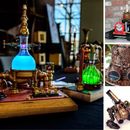Introduction: Amplify Your Gamer Guitar
Perhaps you have built a NES "cigar box"-style 'Gamer Guitar' (book p. 193) and learned to play a few tunes, but you have decided that it is just not loud enough. No matter how hard you wail on your guitar, its little acoustic chamber just can't do that three-chord classic 'Wild Thing' any justice. What is a guitarist to do?
If you have diligently read 62 Projects to Make with a Dead Computer, you perhaps might already know the answer. As the project aptly titled 'Acoustic Rock Revolution' (book p. 184) demonstrates, you must amplify! Yes my friends, it is time to amplify your Gamer Guitar and rock out in your garage like a hurricane (or at least a tropical depression - exotic and angsty).
you perhaps might already know the answer. As the project aptly titled 'Acoustic Rock Revolution' (book p. 184) demonstrates, you must amplify! Yes my friends, it is time to amplify your Gamer Guitar and rock out in your garage like a hurricane (or at least a tropical depression - exotic and angsty).
Using a handful of basic, easy-to-find, parts and tools, I'm going to show you how to perform this operation in a matter of minutes.
For those about to rock, I salute you.
(Note: In the video, I sent the guitar through a killer fuzz pedal. Normal amplification is cleaner sounding and with less feedback.)
If you have diligently read 62 Projects to Make with a Dead Computer,
Using a handful of basic, easy-to-find, parts and tools, I'm going to show you how to perform this operation in a matter of minutes.
For those about to rock, I salute you.
(Note: In the video, I sent the guitar through a killer fuzz pedal. Normal amplification is cleaner sounding and with less feedback.)
Step 1: Go Get Stuff
You will need:
- A 1/4" male mono plug
(These are available at Radioshack or most guitar shops.)
- A piezo element
(You can find these in many devices including broken touch tone phones or PDAs. They can also be purchased at Radioshack)
- A NES controller cable
(I used the cable left over from Laser Gag Zapper [book p. 138] because it tends to be longer than normal NES controller cables. This is good for playing the guitar.)
- A 1/4" male mono plug
(These are available at Radioshack or most guitar shops.)
- A piezo element
(You can find these in many devices including broken touch tone phones or PDAs. They can also be purchased at Radioshack)
- A NES controller cable
(I used the cable left over from Laser Gag Zapper [book p. 138] because it tends to be longer than normal NES controller cables. This is good for playing the guitar.)
Step 2: Take Apart the Plug
Disassembled your 1/4" mono male plug. Typically you can twist it open and then simply separate the pieces.
Step 3: Prepare to Solder
Trim the NES cable free from any circuit board it may be attached to. Also, trim the wires shorter so that only an inch of wire is protruding from the end of the cable.
Strip the jacketing off the white and brown wires.
Finally, slide the outer jacket of the mono plug onto the NES cable if it seems like you won't be able to reassemble the plug assembly after soldering. Basically, most plugs twist together and you won't be able to twist it shut if the piece isn't already passed onto the wire before you solder.
Strip the jacketing off the white and brown wires.
Finally, slide the outer jacket of the mono plug onto the NES cable if it seems like you won't be able to reassemble the plug assembly after soldering. Basically, most plugs twist together and you won't be able to twist it shut if the piece isn't already passed onto the wire before you solder.
Step 4: Solder
Solder the white wire to the metal lug protruding from the back of the male plug.
Solder the brown wire to the shield on the side of the male plug.
Solder the brown wire to the shield on the side of the male plug.
Step 5: Reassemble
Once the two wires are soldered, put your plug back together in the same manner that you took it apart.
Step 6: Case Open
Remove the back half of your Gamer Guitar by removing all of the necessary screws.
Step 7: More Soldering
Locate the wiring harness for the first player controller socket.
Free the brown and white wires from the plastic connector.
Strip 1/4" of the jacket from each of these wires.
Twist the brown wire together white the black wire from the piezo and white wire together with the red wire from the piezo.
Solder both pairs together.
Finally insulate them using electrical tape. I didn't have any electrical tape on hand, so I glued the two pairs together with hot glue in such a way that the metal contacts could never meet (see last image below).
Free the brown and white wires from the plastic connector.
Strip 1/4" of the jacket from each of these wires.
Twist the brown wire together white the black wire from the piezo and white wire together with the red wire from the piezo.
Solder both pairs together.
Finally insulate them using electrical tape. I didn't have any electrical tape on hand, so I glued the two pairs together with hot glue in such a way that the metal contacts could never meet (see last image below).
Step 8: Attach the Pickup
Using double-sided tape, attach the piezo pickup somewhere along the top side of the guitar near the bridge. You can experiment placing the pickup at various spots inside the guitar body to achieve various sounds.
Step 9: Case Closed
Close the case pack up and replace all of the screws.
Step 10: Plug and Play
Plug the NES end of the wire you made into the first player socket and the music end into your amp and get ready to rock.





